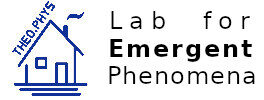Master thesis – Leander Self
Leander Self
A Neisseria gonorrhoeae colony under shear: Viscoelasticity of an active network [PDF]
finished 2020-12
supervised by Michael Schmiedeberg
Abstract
One of the most prevalent sexually transmitted diseases, gonorrhea, is caused by the bacterium Neisseria gonorrhoeae. Cells of this species use retractable appendages, called pili, in the process of colonisation and infection. They serve several purposes, one of them being the formation of bacterial communities. The resulting biofilms and their precursors, microcolonies, are a means of protection from external influences, such as human intervention. Microbial biofilms are ubiquitous and can be beneficial as well as detrimental to us. Bacterial cells are often dispersed in a flowing fluid and colonize immersed surfaces. For instance Neisseria gonorrhoeae has to resist the flow of urin, as it mostly affects the genitourinary system. Hence, studying bacterial adhesion under flow is of significant practical relevance. Therein, viscoelastic properties are an important aspect, as these are part of what makes bacterial aggregates resilient and hard to remove. Insight toward which factors affect such properties may help in treatment of harmful bacterial infestation. On the other hand, it may also aid in creating and maintaining similarly resilient, beneficial materials. Therefore it is not surprising that research regarding mechanics and viscoelasticity of biofilms has steadily grown in the past decades. The same is also true for the field of active colloidal matter. Independently moving and interacting bacteria suspended in fluids can be categorized as such. This is an important class of soft matter generally, because it shows emergence of unique mechanical and dynamic properties. Hence materials with embedded activity make possible applications in industrial coatings, medicine and robotics interesting.To possibly aid in these endeavours, this thesis investigates rheologic properties of a network of active colloidal matter in the form of a bacterial colony. To this end, such a model is numerically implemented. It is a hybridised and modified version of previously proposed models for microcolonies of the Neisseria gonorrhoeae bacterium. The system is tested with dynamic mechanical analysis. Here controlled shear deformation in oscillating form is used. Several amplitude as well as frequency sweeps are executed. Thereby the viscoelastic moduli are determined in dependence of the amplitude and frequency of deformation, which describes the viscoelastic behaviour of a material to a large extent. Particular attention is given to the aspect of activity.
One of the most prevalent sexually transmitted diseases, gonorrhea, is caused by the bacterium Neisseria gonorrhoeae. Cells of this species use retractable appendages, called pili, in the process of colonisation and infection. They serve several purposes, one of them being the formation of bacterial communities. The resulting biofilms and their precursors, microcolonies, are a means of protection from external influences, such as human intervention. Microbial biofilms are ubiquitous and can be beneficial as well as detrimental to us. Bacterial cells are often dispersed in a flowing fluid and colonize immersed surfaces. For instance Neisseria gonorrhoeae has to resist the flow of urin, as it mostly affects the genitourinary system. Hence, studying bacterial adhesion under flow is of significant practical relevance. Therein, viscoelastic properties are an important aspect, as these are part of what makes bacterial aggregates resilient and hard to remove. Insight toward which factors affect such properties may help in treatment of harmful bacterial infestation. On the other hand, it may also aid in creating and maintaining similarly resilient, beneficial materials. Therefore it is not surprising that research regarding mechanics and viscoelasticity of biofilms has steadily grown in the past decades. The same is also true for the field of active colloidal matter. Independently moving and interacting bacteria suspended in fluids can be categorized as such. This is an important class of soft matter generally, because it shows emergence of unique mechanical and dynamic properties. Hence materials with embedded activity make possible applications in industrial coatings, medicine and robotics interesting.To possibly aid in these endeavours, this thesis investigates rheologic properties of a network of active colloidal matter in the form of a bacterial colony. To this end, such a model is numerically implemented. It is a hybridised and modified version of previously proposed models for microcolonies of the Neisseria gonorrhoeae bacterium. The system is tested with dynamic mechanical analysis. Here controlled shear deformation in oscillating form is used. Several amplitude as well as frequency sweeps are executed. Thereby the viscoelastic moduli are determined in dependence of the amplitude and frequency of deformation, which describes the viscoelastic behaviour of a material to a large extent. Particular attention is given to the aspect of activity.
